RANDOM WALK AND RESERVES MODELING IN STUDYING PENSIONS FUNDS SUSTAINABILITY
Event Title
QUANTITATIVE METHODS IN ECONOMICS (Multiple Criteria Decision Making XXI)
Year (definitive publication)
2022
Language
English
Country
Slovakia
More Information
Web of Science®
This publication is not indexed in Web of Science®
Scopus
This publication is not indexed in Scopus
Google Scholar
This publication is not indexed in Google Scholar
This publication is not indexed in Overton
Abstract
Random walk is a stochastic process classic example, used to study a set of phenomena
and, particularly, as in this article, models of reserves evolution. Random walks also allow the construction of significant complex systems and are also used as an instrument of analysis, being used in the sense of giving a theoretical characteristic to other types of systems. Our goal is primarily to study reserves to see how to ensure that pension funds are sustainable. This classic approach to the pension funds study makes it possible to draw interesting conclusions about the problem of reserves.
Acknowledgements
This work is partially financed by national funds through FCT -
Fundação para a Ciência e Tecnologia, I.P., under the project FCT UIDB/04466/2020.
Furthermore, the author thanks the ISCTE-IUL and ISTAR-IUL, for their support.
Keywords
Reserves,Ruin,Random walks,Pensions funds
Fields of Science and Technology Classification
- Mathematics - Natural Sciences
- Economics and Business - Social Sciences
Funding Records
| Funding Reference | Funding Entity |
|---|---|
| This work is partially financed by national funds through FCT - Fundação paraUIDB/04466/2020 | FCT-Fundação para a Ciência e Tecnologia, I.P. |
Contributions to the Sustainable Development Goals of the United Nations
With the objective to increase the research activity directed towards the achievement of the United Nations 2030 Sustainable Development Goals, the possibility of associating scientific publications with the Sustainable Development Goals is now available in Ciência_Iscte. These are the Sustainable Development Goals identified by the author(s) for this publication. For more detailed information on the Sustainable Development Goals, click here.

 Português
Português


